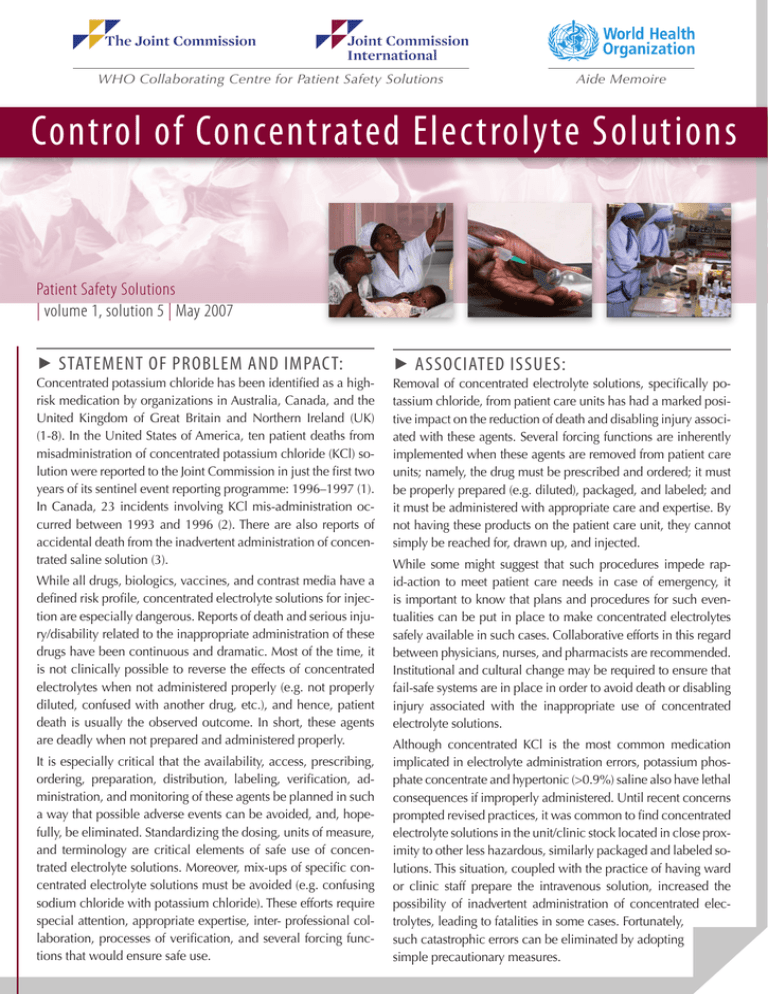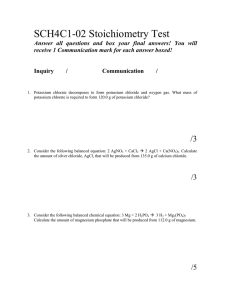
WHO Collaborating Centre for Patient Safety Solutions
Aide Memoire
Control of Concentrated Electrolyte Solutions
Patient Safety Solutions
| volume 1, solution 5 | May 2007
▶ Statement of Problem and Impact:
Concentrated potassium chloride has been identified as a highrisk medication by organizations in Australia, Canada, and the
United Kingdom of Great Britain and Northern Ireland (UK)
(1-8). In the United States of America, ten patient deaths from
misadministration of concentrated potassium chloride (KCl) solution were reported to the Joint Commission in just the first two
years of its sentinel event reporting programme: 1996–1997 (1).
In Canada, 23 incidents involving KCl mis-administration occurred between 1993 and 1996 (2). There are also reports of
accidental death from the inadvertent administration of concentrated saline solution (3).
While all drugs, biologics, vaccines, and contrast media have a
defined risk profile, concentrated electrolyte solutions for injection are especially dangerous. Reports of death and serious injury/disability related to the inappropriate administration of these
drugs have been continuous and dramatic. Most of the time, it
is not clinically possible to reverse the effects of concentrated
electrolytes when not administered properly (e.g. not properly
diluted, confused with another drug, etc.), and hence, patient
death is usually the observed outcome. In short, these agents
are deadly when not prepared and administered properly.
It is especially critical that the availability, access, prescribing,
ordering, preparation, distribution, labeling, verification, administration, and monitoring of these agents be planned in such
a way that possible adverse events can be avoided, and, hopefully, be eliminated. Standardizing the dosing, units of measure,
and terminology are critical elements of safe use of concentrated electrolyte solutions. Moreover, mix-ups of specific concentrated electrolyte solutions must be avoided (e.g. confusing
sodium chloride with potassium chloride). These efforts require
special attention, appropriate expertise, inter- professional collaboration, processes of verification, and several forcing functions that would ensure safe use.
▶ Associated Issues:
Removal of concentrated electrolyte solutions, specifically potassium chloride, from patient care units has had a marked positive impact on the reduction of death and disabling injury associated with these agents. Several forcing functions are inherently
implemented when these agents are removed from patient care
units; namely, the drug must be prescribed and ordered; it must
be properly prepared (e.g. diluted), packaged, and labeled; and
it must be administered with appropriate care and expertise. By
not having these products on the patient care unit, they cannot
simply be reached for, drawn up, and injected.
While some might suggest that such procedures impede rapid-action to meet patient care needs in case of emergency, it
is important to know that plans and procedures for such eventualities can be put in place to make concentrated electrolytes
safely available in such cases. Collaborative efforts in this regard
between physicians, nurses, and pharmacists are recommended.
Institutional and cultural change may be required to ensure that
fail-safe systems are in place in order to avoid death or disabling
injury associated with the inappropriate use of concentrated
electrolyte solutions.
Although concentrated KCl is the most common medication
implicated in electrolyte administration errors, potassium phosphate concentrate and hypertonic (>0.9%) saline also have lethal
consequences if improperly administered. Until recent concerns
prompted revised practices, it was common to find concentrated
electrolyte solutions in the unit/clinic stock located in close proximity to other less hazardous, similarly packaged and labeled solutions. This situation, coupled with the practice of having ward
or clinic staff prepare the intravenous solution, increased the
possibility of inadvertent administration of concentrated electrolytes, leading to fatalities in some cases. Fortunately,
such catastrophic errors can be eliminated by adopting
simple precautionary measures.
▶ Suggested Actions:
▶ Looking Forward:
The following strategies should be considered by WHO
Member States.
Member states recommend that:
1. Ensure that health-care organizations have systems
and processes in place wherein:
a. The promotion of safe practices with potassium
chloride and other concentrated electrolyte solutions is a priority and where effective organization
risk assessments address these solutions.
b. Potassium chloride is treated as a controlled substance, including requirements that restrict ordering and establish storage and documentation
requirements.
c. Ideally, removal of concentrated electrolyte solutions from all nursing units is accomplished, and
these solutions are only stored in specialized
pharmacy preparation areas or in a locked area.
Potassium vials, if stored in a specialized patient
care area, must be labeled individually with a visible florescent warning label that states MUST BE
DILUTED.
d. When a pharmacist or pharmacy preparation area
is not available to store and prepare these solutions,
only a trained and qualified individual (physician,
nurse, pharmacy technician) prepares the solutions.
e. After solution preparation, there is independent
verification of the electrolyte solution by a second
trained and qualified individual. The organization
should establish a checklist that is used for the independent verification. Checklist items should include concentration calculations, infusion pump
rates, and correct line attachments.
f. The prepared solution is labeled with a HIGH RISK
WARNING label prior to administration.
g. An infusion pump is used to administer concentrated solutions. If an infusion pump is not available,
other infusion devices, such as buretrol administration tubing (tubing with an inline receptacle that
limits the volume that will flow into the patient),
may be considered for use, but infusions of concentrated solutions must be monitored frequently.
h. An organizational safety infrastructure supports
the training of qualified individuals through
policies, procedures, best practices, and annual
recertification.
i. Physician orders include the rates of infusion for
these solutions.
1. Concentrated electrolyte solutions be purchased by
the health-care organization only in standardized and
limited drug concentrations.
2. The health-care organization purchases and uses only
premixed parenteral solutions.
3. The organization petitions the drug manufacturing industry to utilize HIGH RISK WARNING labels on all
concentrated electrolyte solutions.
4. Regulatory agencies and drug manufacturers should
be engaged to improve the safety of manufacturing
these types of concentrated electrolyte solutions.
▶ Strength of Evidence:
▶ Expert consensus.
▶ Applicability:
▶ Hospitals, ambulatory care facilities, ambulatory surgical
centers, dialysis centers, and any other facilities that use
and administer concentrated electrolyte solutions.
▶ Opportunities for Patient and
Family Involvement:
▶ Ask what medications are being given and why they are
being given.
▶ Learn to recognize that potassium chloride solutions and
other high concentration electrolyte solutions may create
dangerous situations. Ask for clarification regarding their
need and route of administration if they are to be given.
▶ Ensure positive identification before receiving
medication.
▶ Potential Barriers:
▶ Some organizations have limited pharmacy services.
▶ Perceived need to have electrolyte concentrates immediately available—especially for urgent or emergent
situations.
▶ Economics (current low cost of pharmaceutical production of concentrated products—having pre-mixed KCL
bags will increase cost).
▶ Lack of technology required for safe administration
(e.g. infusion devices).
▶ Lack of staff awareness of the risk.
▶ Insufficient generally accepted research, data, and
economic rationale regarding cost-benefit analysis
or return on investment (ROI) for implementing these
recommendations.
▶ Risks for Unintended
Consequences:
▶ Unacceptable delays in obtaining needed electrolyte
solutions from the pharmacy.
▶ Gradual stockpiling of unused solutions on the nursing
units for future use.
▶ References:
1.
Medication error prevention—potassium chloride. Sentinel Event
Alert,Issue1,27February1998.JointCommission.http://www.jointcommission.org/SentinelEvents/SentinelEventAlert/sea_1.htm.
2.
Alert on potassium chloride solutions. National Patient Safety
Agency (United Kingdom), 23 July 2002.
3.
DiPaulo M et al. Accidental death due to erroneous intravenous infusion of hypertonic saline solution for hemodialysis. International
Journal of Artificial Organs, 2004, 27(9):810–812.
4.
High-alert medications and patient safety. Sentinel Event Alert,
Issue 11, 19 November 1999. Joint Commission. http://www.jointcommission.org/SentinelEvents/SentinelEventAlert/sea_11.htm.
5.
Intravenous potassium chloride can be fatal if given inappropriately. Safety and Quality Council (Australia) Medication Alert,
October 2003.
6.
Update on the implementation of recommended safety controls
for potassium chloride in the NHS. National Patient Safety Agency
(United Kingdom), 6 November 2003.
7.
More on potassium chloride. ISMP Canada Safety Bulletin, 3(11),
November 2003.
8.
Concentrated potassium chloride: a recurring danger. ISMP
Canada Safety Bulletin, 4(3), March 2004.
▶ Other Selected Resources:
1.
American Iatrogenic Association. Fatal errors: hospitals
learn lessons the hard way, 1997.
2.
Brown TR. Institutional pharmacy practice, 4th ed. Bethesda,
MD, American Society of Health-System Pharmacists, 2006
3.
External Patient Safety Review. Calgary Health Region. June
2004.
4.
ISMP Canada potassium chloride safety recommendations
summary: http://www.hqca.ca/pages/news_pages/FINAL_
ISMP.pdf
5.
Joint Commission Sentinel Event Alert, High-Alert Medications
andPatientSafety,November19,1999,Issue11:http://www.jointcommission.org/SentinelEvents/SentinelEventAlert/sea_11.htm
6.
Manasse HR, Thompson KK. Medication safety: a guide for
health care facilities. Bethesda, MD, American Society of
Health-System Pharmacists, 2005
7.
Medication Safety Recommendations from the Institute of
Medicine’s To Err Is Human: Building a Safer Health System:
http://www.nap.edu/catalog.php?record_id=9728
8.
Medication Safety Taskforce of the Australian Council
for Safety and Quality in Healthcare. Intravenous potassium chloride can be fatal of given inappropriately.
October 2003.
9.
NPSA Alert on potassium chloride concentrate solutions:
http://www.npsa.nhs.uk/site/media/documents/486_riskalertpsa01.pdf
10. National Quality Forum Never Events: http://www.qualityforum.org/pdf/news/txSREReportAppeals10-15-06.pdf
11. Stevenson T. The National Patient Safety Agency. Archives of
Disease in Childhood, 90: 2005.
12. Tisdale JE, Miller DA. Drug-induced diseases: prevention,
detection and management. Bethesda, MD, American
Society of Health-System Pharmacists, 2005
13. Wright v. Abbott Lab, Inc. Nurse’s act intervenes to preclude
manufacturer liability. 10th Circuit. 6 August 2001.
14. United States Department of Defense. Patient Safety
Program, Patient Safety Center Alert. Concentrated
electrolyte solutions and high dose epinephrine.
21 November 2003.
© World Health Organization 2007
All rights reserved. Publications of the World Health Organization can be obtained from WHO Press, World Health Organization, 20 Avenue Appia, 1211
Geneva 27, Switzerland (tel.: +41 22 791 3264; fax: +41 22 791 4857; e-mail:
bookorders@who.int ). Requests for permission to reproduce or translate WHO
publications – whether for sale or for noncommercial distribution – should be
addressed to WHO Press, at the above address (fax: +41 22 791 4806; e-mail:
permissions@who.int ).
The designations employed and the presentation of the material in this publication do not imply the expression of any opinion whatsoever on the part of the
World Health Organization concerning the legal status of any country, territory,
city or area or of its authorities, or concerning the delimitation of its frontiers or
boundaries. Dotted lines on maps represent approximate border lines for which
there may not yet be full agreement.
The mention of specific companies or of certain manufacturers’ products does not
imply that they are endorsed or recommended by the World Health Organization
in preference to others of a similar nature that are not mentioned. Errors and
omissions excepted, the names of proprietary products are distinguished by initial
capital letters.
All reasonable precautions have been taken by the World Health Organization
to verify the information contained in this publication. However, the published
material is being distributed without warranty of any kind, either expressed or
implied. The responsibility for the interpretation and use of the material lies with
the reader. In no event shall the World Health Organization be liable for damages
arising from its use.
This publication contains the collective views of the WHO Collaborating Centre
for Patient Safety Solutions and its International Steering Committee
and does not necessarily represent the decisions or the stated policy
of the World Health Organization.




